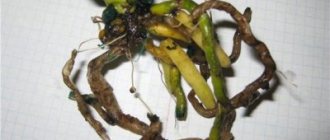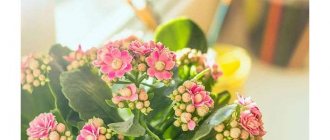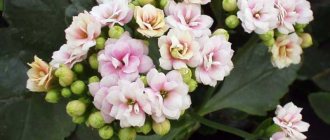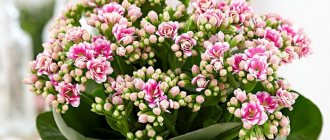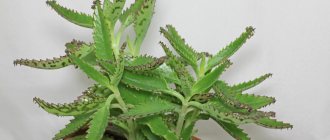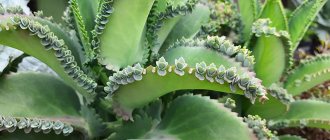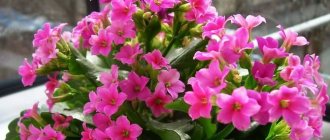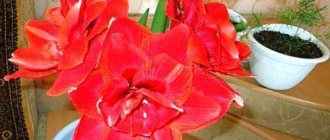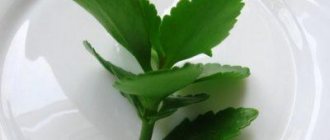How to make Kalanchoe bloom?
At the same time, stress allows you to spur the ejection of a bud, but only if it does not last long and is controlled from the outside. Experts know what to do if a previously flowering Kalanchoe no longer blooms and suddenly loses all its ovaries. The sequence of actions should be as follows:
- Increasing the frequency of watering. The soil under the succulent should be constantly moist for 2-3 days.
- Double dose of fertilizer. Spontaneous feeding outside the plan will force the plant to grow “dormant” ovaries.
- Loosening the soil at the roots. Aeration of the root system enhances the immunity of the buds.
Kalanchoe Blossfeld does not bloom - what to do?
There are at least 130 varieties of the Blossfeld variety: each of them has small double flowers in a wide variety of shades - pink, orange, red and yellow. Kalanchoe Blossfeld does not bloom if it grows in a dark place. It also does not like direct light, but responds with a large number of ovaries to bright light. The correctness of care that stimulates flowering can be determined by two criteria:
- The presence of a red border on the leaves of the plant. When Kalanchoe does not bloom, ovaries do not appear if the leaves have a uniform green color. The red “stripe” signals that the plant is receiving the required amount of water and nutrients.
- No fungal diseases. If brown spots appear on the leaves, they are removed and the cut areas are treated with a fungicide.
Kalanchoe Kalandiva does not bloom
The Kalandiva variety is considered the most adapted to living in an apartment or house. Its bright double flowers are collected in large inflorescences, so if one inflorescence dies, the petals of the neighboring ones also dry out. It has one peculiarity: while other succulents lose their ability to bear flowers due to moisture getting on the leaves, Kalandiva, even considering that it is a subspecies of Kalanchoe, does not bloom unless it is sprayed. It does not tolerate dry air very well, so you need to spray the plant with water at room temperature at least 2-3 times a day.
How to prune Kalanchoe to bloom?
Pruning is recommended for any type of this ornamental plant as a measure to stimulate flowering. The process involves removing excess leaves or diseased peduncles to prevent the development of diseases and give a neat shape.
Since as the stem develops, the upper shoots tend to thin out and become sterile, it is important to know how to properly pinch a Kalanchoe to bloom. These two processes (pinching and cutting) are similar to each other, so they can be combined into one:
- First you need to select the weakest tops of the plant, which have not been covered with flowers for a long time.
- Using scissors or fingers, a small part of the stem is removed with the expectation that the remaining wound will be small.
- After pinching, the edges of the stems are sprinkled with ash or charcoal to prevent dying.
Kalanchoe flower - how to care for it to bloom?
In order for ovaries to appear on a houseplant, its care regimen must be radically revised. You don’t need to think about how to make Kalanchoe bloom at home—you just need to eliminate factors that impede this process. These include:
- Excess sunlight. Constant stay on the windowsill, located on the sunny side of the home, causes the plant to grow in height, spending all the juices on this process.
- Avoiding overwatering. The leaves of the bush are able to accumulate moisture and consume it gradually, so a lack of water is not as destructive as its excess. In summer, the procedure must be repeated once a week, in winter - twice.
- Fertilizer with a special complex for succulents. If a Kalanchoe does not bloom, no matter what its owner tries to do, this may mean that it needs a mineral complex with potassium, sodium and manganese in its composition.
Optimal conditions for Kalanchoe
Some types of Kalanchoe can be classified as shade-tolerant plants, but certainly not lush-flowered bushes. They also do not like direct sun and will prefer diffused lighting, but it should be as bright as possible. Eastern and western window sills or places similar to them in terms of light levels are excellent for Kalanchoe.
On cloudy days and during winter flowering, additional lighting will allow you to prolong flowering (at least up to 8, ideally up to 10-12 hours). But limiting daylight hours, without which, according to myths, Kalanchoe cannot be grown, is of no use to flowering bushes. It is used only to achieve budding, and not to prolong flowering.
Kalanchoe is much less demanding on temperatures. It can grow in a wide range of temperatures from 10 to more than 25 degrees Celsius, but during flowering, stable warmth in summer (+21...+23 °C) and slight coolness in autumn-winter (+16...+18 °C) is the best option.
Severe temperature changes can lead to accelerated flowering. And drafts, which Kalanchoe is not afraid of at other times, are undesirable during flowering. Unlike ventilation, which allows you to prolong flowering. And one more secret - it is undesirable to rearrange and rotate flowering Kalanchoes.
Kalanchoe does not like direct sun and will prefer diffused lighting, but it should be as bright as possible
How to choose a good Kalanchoe flower in a store
To select a healthy and viable plant in the store, you must follow these rules.
Stem
During an external inspection, you need to check the safety of the stem and its elasticity. Determine how firmly the plant is rooted in the substrate. If the plant stem “dangles” in the container, there is a fairly high risk of hidden mechanical damage to the root system during transportation.
Important! You should choose a plant with an even distribution of foliage on the stem, without bald spots. The presence of a bare stem indicates injury to the plant.
Leaf color
In terms of color, the leaves and stem of the plant should have a uniform, uniform color, without white bloom, brown spots and yellowed edges of the leaf blades. It is necessary to especially carefully check the condition of the lower leaves; they must be healthy, not wrinkled, or darkened from excess moisture.
Inflorescences
In flowering species, it is necessary to carefully examine the inflorescences. They should contain as many closed buds and barely blooming flowers as possible. The presence of faded inflorescences and, especially, drying panicles in the selected specimen indicates that the plant has been blooming for a long time, and soon it needs to be prepared for a dormant period.
Substrate
It is very important to check the condition of the earthen substrate in the transport container. The earthen ball should not be too wet, and in the lower part near the holes for draining the liquid it should not be sour
Excessive humidity and mass processing of plants in chain supermarkets can harm the plant and stimulate the process of rotting of the root system, which can lead to subsequent withering of the plant.
It is better to choose plants with a dry earthen lump. Excessive waterlogging is more likely to kill Kalanchoe than short drying. Thanks to its succulent properties and ability to accumulate liquid in the stem and leaves, Kalanchoe is able to withstand short-term drought without serious consequences.
Important! When purchasing, you need to choose the right Kalanchoe. Home care after purchase involves observing an adaptation period and further transplantation
Kalanchoe is a short-day plant. To stimulate the budding process, a short day lasting less than 8 hours is artificially created. To do this, cover the bush with a cap that does not allow light to pass through, or put the pot in a closet.
Types of flowering Kalanchoe
Kalanchoe of all types blooms, but only some can call the blossoming corollas decorative. Most representatives of the genus are decorative foliage or medicinal indoor plants.
Blossfeld
Kalanchoe blossfeldiana is the most common and popular species. The shoots are erect, about 30 cm high. They branch well.
Leaves:
- ovoid;
- with rounded teeth along the edge;
- dark green;
- maximum size 7x4 cm.
The flowering period of Kalanchoe Blossfeld is from February to May. The corollas are simple, in the species plant they are red, collected in loose umbrellas. Varieties of various colors.
Kalandiva
The most popular series with densely double corollas reminiscent of roses. Previously, the buds bloomed in winter. Modern hybrids can bloom with proper care at home all year round with breaks of 1.5-2 months.
It is distinguished by rounded petals of various colors. The height of the bushes is about 25-30 cm; within the series there are mini varieties up to 15 cm tall.
Rosaline
Another variety series Kalanchoe blossfeldiana. It also prefers to bloom in the cold season, with double petals, but not rounded, but pointed. Grows up to 25 cm.
Mangina
Kalanchoe manginii - Kalanchoe blooms from late spring. The species is a hanging plant with drooping shoots, small, bright green, oval leaves.
Corollas:
- hang on long thin peduncles;
- collected in loose brushes;
- large;
- elongated;
- campanulate;
- can bloom yellow, pink, orange, crimson, purple;
- The coloring of the corollas is often combined.
The Mangina species is often called the African bluebell.
Fedchenko
Kalanchoe fedtschenkoi is a rather rare plant in cultivation. Kalanchoe blooms at home in spring.
Tubular beaters:
- orange or apricot shades;
- covered with pearly sepals;
- collected in sparse clusters;
- hanging on long, curved stalks.
The plant is erect, the shoots branch well, the internodes are short. Leaves:
- obovate;
- dove-blue;
- often with pink, white, purple markings or borders;
- the tip of the plate is serrated.
Care
Location and lighting
Loves bright rooms with diffused light. In the summer, it should be placed on windows located towards the west and east. Direct sunlight should be avoided to avoid leaf burns. Loves fresh air, but drafts should be avoided. In winter and during the flowering period, you can use phytolamps if daylight is not enough (the plant begins to stretch and the inflorescences become smaller). The complete absence of light also negatively affects indoor plants.
Temperature
The Kalanchoe flower can easily withstand high temperatures in summer, up to thirty degrees or more. In winter, you need to maintain a cool temperature of +16-18 degrees (not lower than +10), this helps the rapid formation of flower buds. When it is cool, the flower becomes comfortable to bloom. If the room is too hot, this process is suspended.
Air humidity
Air humidity does not play a key role in the life of a plant. Kalanchoe thrives in both dry air and high humidity. There is no need to spray the plant, but sometimes you can wipe the leaves with a damp cloth or sponge to remove dust. After this procedure, it is necessary to repeat wiping with a dry cloth.
Watering
Moderate, with drying out of the top layer of soil. In summer - about 1-2 times a week (but do not forget to check the soil). In winter, watering should be done a minimum number of times. Kalanchoe can tolerate an insufficient amount of water, but an excess will destroy it, because... may lead to root rot. If the soil dries out greatly, the plant may shed its leaves.
The soil
For such an unpretentious plant as Kalanchoe, you can choose any soil for succulents. It can usually be found in many flower shops. A skilled gardener can create such soil himself. To do this, you need to mix peat, turf and leaf soil in equal quantities. You can add charcoal. It is necessary to put drainage at the bottom of the flower pot.
Fertilizer
It is enough to fertilize non-flowering species once a month during the growth period (spring-summer). They bloom once every three weeks in spring and summer, and also in autumn (for the formation of flower buds). In cold weather, you should absolutely not fertilize the plant. Even if it withers, you cannot fertilize it in winter. It is recommended to use store-bought fertilizers for succulents or complex fertilizers (mineral and organic) with a low nitrogen content.
Transfer
It is necessary to replant a houseplant if the flower pot in which the Kalanchoe is currently located becomes too small for it. Replanting may also be required when the plant’s soil begins to rot after prolonged watering.
Young Kalanchoe requires annual replanting due to the rapid growth of roots. It is recommended to do this when the spring period ends. To replant, you need to take the plant out of the flower pot along with a small amount of soil, place it in another and water it.
Then the plant begins to slowly adapt to its new “place of residence.” In the new pot, it is necessary to maintain equal proportions of new soil and existing soil. Most often, Kalanchoe goes through an adaptation period of seven days. After which you can feed the flower. When choosing a new flower pot, you should choose wide and deep shapes. .
Medicinal properties
Juice is extracted from the shoots of Kalanchoe pinnate, which is used to prepare medicines on an industrial scale. Its effectiveness has been proven through scientific research. The medicinal properties of Kalanchoe Degremona have not been recognized by the scientific community, but the juice from this plant is used in folk medicine.
Johann Wolfgang Goethe believed that daily consumption of Kalanchoe “air babies” rejuvenates the body.
Below is a table showing the names and principles of treatment of the main types of diseases.
| Common name | Name of the disease | Treatment principle |
| Oral diseases | Periodontitis, gingivitis, inflammation of the oral mucosa | Apply a tampon soaked in juice for 10-15 minutes several times a day. |
| Periodontitis | Inhale with juice. | |
| Respiratory diseases | Runny nose, flu | Place 5 drops of juice in both nostrils to prevent diseases. |
| Sore throat, sore throat | Gargle with a mixture of equal amounts of water and juice. | |
| Vascular diseases | Varicose veins | Prepare a tincture from equal volumes of leaves and a 40% alcohol solution or vodka. Keep it in a dark place for a week, shaking it occasionally. Rub the resulting tincture on your feet at night. |
| Eye diseases | Destruction of the vitreous body | Prepare a mixture of Kalanchoe, viviparus and aloe juice, taking these ingredients in a ratio of 1:1:2. Place the solution in both eyes, 2 drops 2 times a day. |
| Skin diseases | Burn, soft tissue necrosis, other skin defects | Apply a cloth bandage soaked in juice to the affected area of skin or use to lubricate the surface of wounds. |
| Erysipelas | Prepare a mixture of equal amounts of 0.5% procaine solution and juice. Moisten the compress with it, which then apply to the skin. | |
| Squamosal lichen | Make an ointment from a mixture of juice, eucalyptus oil and honey, taken in a ratio of 1:3:1. Leave the resulting mixture for 3 days, and then put the ointment in a dark jar. Use as needed. |
The juice of Kalanchoe leaves and stems is used in gynecology and obstetrics. Cosmetic products are made on its basis, after the use of which the aging process slows down.
Origin of Kalanchoe
The described inhabitant of the windowsill is considered a medicinal representative of the flora, often used for nasal congestion and other inflammatory processes. The question of whether flowering Kalanchoe can be used for medicinal purposes is still controversial. But even if it is impossible to get rid of a runny nose with the help of such a plant, it will delight its owners with its flowers.
This type of indoor decoration belongs to the Crassulaceae family, and translated means “plant with thick skin.”
The island of Madagascar is considered the birthplace of the green creature, but its growth can be found almost throughout Asia. The flowering beauty is grown both in greenhouses and in the room. This type of indoor decoration belongs to the Crassulaceae family, and translated means “thick-skinned plant.” Thanks to its thick stems and leaves, it accumulates moisture and goes without watering for a long time. Evaporation is prevented by a thin film covering the leaves and stems. All these features must be taken into account in order to care for a blooming creature.
Let's highlight the basic principles of care:
- Watering mode.
- Requirements for illumination and temperature.
- Transfer.
- Reproduction methods.
- Feeding, pruning.
- Protection from diseases.
Now let’s try to consider each of the mentioned principles in detail.
Video clip on how to grow Kalanchoe at home
Features of Kalanchoe
Before you begin to study the basic requirements for growing Kalanchoe, it would not be superfluous to understand a little what it is. In a word, it is impossible to describe what the plant looks like, because there are up to 200 species of it. There are varieties with round, oval, triangular and even tubular or lacy-pinnate leaves. Each of them is beautiful in its own way, and almost all of them are in bloom. This is not such a common occurrence among the Crassulaceae family, to which Kalanchoe belongs. But if in some species flowering can be seen very rarely, others bloom their buds every year.
Flowering Kalanchoe is a very beautiful sight. This usually occurs in the spring, but sometimes inflorescences appear even in winter if the plant is kept warm. The color scheme will delight you with variety and bright colors. There are white, red, pink, yellow varieties, for example, as in the photo below. Terry varieties of the crop look gorgeous with small but full flowers that look like miniature roses.
In general, 2 groups of Kalanchoe are most often distinguished:
- Medicinal. They are only two types of plants: Degremona and pinnate. The first has triangular, sharp leaves, dark green with purple spots on the bottom. The second leaves are monochromatic, green, covered with a bluish coating, and more rounded, only the very tip is sharp.
- Beautifully flowering. They have a wide range of varieties with abundant, colorful and long-lasting flowering. Among them are Blossfeld, Kalandiva, its hybrid called Mix, as well as Rosalina, Mangina.
Separately, we can distinguish species that bloom, but very rarely and unremarkably. These include Kalanchoe tomentosa, dissected. These plants are grown for their beautiful decorative appearance. Their main advantage and decoration is the unusual shape of the leaf plates.
Why does Kalanchoe start to grow upward and stop blooming?
There are several reasons why a plant does not produce flowers. The main ones are:
- Lack of knowledge by the owner of the flower about the technology of growing the plant. After all, in the store the seller said that this potted crop does not require special care.
- There is not enough lighting for flowering. As a result, the shoots begin to stretch; they simply do not have enough strength to begin to form inflorescences.
- Very often, when we come to the store, we see flowering bushes. It seems to us that this culture is constantly blooming. But this impression is deceptive. To get this look, flower suppliers, before sending them to the store, achieve the appearance of buds by ordinary forcing.
- A small plant with a small root system is planted in a transportable pot. The soil in it contains special fertilizers that are valid only for two months. This Kalanchoe is kept for several days in a short daylight hours, usually 10 hours. The bushes begin to lay flower buds.
- When such a plant turns out to be in good home conditions, where normal lighting and temperature are created for it, it continues to bloom, thanks to the nutrients remaining in the pot.
To see a flowering bush again, you need to help the plant, it must gain strength and begin to bloom in good home conditions.
Features of flowering
In fact, this beautiful ornamental plant blooms for quite a long period. Kalanchoe flowers are very beautiful and come in a variety of bright colors. They begin to delight with their beauty during cold weather and snowstorms, that is, in winter. Flowering continues throughout the winter, as well as several spring months.
Most often, Blossfeld Kalanchoe is purchased for growing at home, which delights owners with its flowering for a long time.
It happens that the released buds do not open by spring, in which case the plant simply discards them. However, literally after a month new buds appear and bloom until summer.
There are varieties of Kalanchoe, the flowering of which continues from early spring until autumn. Most often, such specimens are bred artificially. No gardener can definitely answer the question of how long this plant can bloom, since this happens differently in different varieties. In addition, a lot depends on care.
Kinds
Let's look at several popular types of Kalanchoe, often used in indoor floriculture.
Benta
A plant with good decorative properties. A tall, unbranched shrub with a powerful stem and large leaves. It blooms with large white flowers, up to 2.5 centimeters in size. Blooms in April-May, likes cool weather.
Beharskoe
A plant with bare stems and entire pubescent leaves. The length of the leaves reaches 20 centimeters, width - 10. It blooms with small yellow flowers collected in umbrellas.
Blossfeld
The plant has a long flowering period. It reaches a height of 30 centimeters. It has dark green, rounded leaves. The flowers are most often red, but can be yellow, orange or pink.
Felt
Due to the special shape of the pubescent leaves, densely located on the stem, the plant is called “cat ears”. It blooms with small multi-colored flowers that combine red, purple, and silver tones.
Degremona
It can reach half a meter in height. It has fleshy leaves, on the edges of which small rosettes are formed - babies that can take root and germinate. It blooms in winter with bell-shaped inflorescences, purple or pink. Has strong medicinal properties.
Large-flowered
It grows up to 60 centimeters in height, has light green, sometimes reddish leaves. Yellow flowers are collected in umbrellas. Flowering period is May. The birthplace of the flower is India.
Mangina
The plant is distinguished by large pink inflorescences of 10-15 pink bell-shaped flowers. Active flowering occurs in spring.
paniculate
The plant reaches a height of 60 centimeters, densely covered with large silvery leaves. The lower ones are arranged in the form of a rosette, and the upper ones grow less frequently. It blooms with yellow small flowers collected in paniculate inflorescences. Flowering period - late April or May.
Marble
It has oblong leaves with a serrated edge. The plant got its name because of the original color of the leaves. From green they gradually become gray, with brownish splashes. It blooms with white flowers, united in peculiar umbrellas. Has a long flowering period (from January to April).
Cirrus
Cirrus Kalanchoe reaches a meter in height. Densely covered with thick serrated leaves on which daughter rosettes form. Known for its medicinal properties.
Fiery
A low plant with a slightly branched trunk. It blooms with bright red large flowers collected in umbrellas. Does well in cool rooms.
Tubular-flowered
Tall shrub with large oblong leaves. Blooms with beautiful red flowers. The corollas are arranged in the shape of a tube up to 2.5 centimeters long. The plant has many varieties, with flowers in all shades of red.
Dissected
The vertical stem of the bush changes direction of growth over time and begins to droop. It has light green waxy leaves with dissected edges. Blooms with bright orange flowers.
Don Sergio
It has a long flowering period and is very decorative. Thick dark leaves combine pleasantly with bright double inflorescences. The flowering period begins at the beginning of winter.
Kalandiva
A low plant, distinguished by abundant dense double flowers. Large glossy leaves growing in pairs make the plant even more beautiful.
Mix
The plant has a long flowering period (up to six months). It is distinguished by its richness of shades when flowering, unpretentiousness and good healing qualities.
Rosaline
The compact plant blooms with double flowers in delicate pastel colors. It has round, glossy leaves with a wavy edge.
Description and photos of varieties producing buds
Kalanchoe is an evergreen perennial belonging to the group of succulents, the Crassulaceae family. The plant can be recognized by the following external signs:
- has a small or medium bush height;
- has elastic large leaves with a fleshy structure and uneven edges;
- During flowering, a dense carpet of inflorescences consisting of small flowers, the color of which varies from white to rich red tones, is formed on the plant.
Today, about two hundred varieties of Kalanchoe are known . The most common and popular species among gardeners are.
Blossfeld
It has a height of up to 45 cm, rounded leaves with wavy edges and a smooth waxy surface, brightly colored star-shaped flowers, collected in umbellate inflorescences.
Video about Kalanchoe Brossfeld:
Kalandiva
It belongs to the dwarf species, the height of the spreading bush does not exceed 20 cm ; at the ends of the shoots during the flowering period, dense inflorescences of flowers of two shades appear.
Video about Kalanchoe Kalandiva:
Kalanchoe - how to care after flowering
Question: What to do after Kalanchoe blooms, when it has branched out greatly, like a tree, and is almost bald. Is it possible to trim it and how to do it?
Agava: Kalanchoe can be cut any way you like! You can cut cuttings and stick them in the same pot, you can even leave one stump - it will sprout and curl. The only thing is that this applies to the ordinary Blossfeld Kalanchoe, which blooms red. All sorts of hybrids such as white, yellow and pink may die completely after flowering.
Nathanella: There are only two options for how to deal with faded Kalanchoe:
- Take cuttings, root them and get a new plant. It will bloom when it becomes old enough, i.e. probably in a year. Ideally, Kalanchoe Blossfeld is a tall, erect plant (50 cm) with a non-branching stem, so pinching does not give any results. We sell Dutch specimens, which are apical cuttings from an already mature plant. It is not difficult to make them bloom, the main thing is to observe the light regime.
- Try to arrange a “dark” one for an adult plant and get a flowering bush. Kalanchoe is a short-day plant, i.e. In order for the bush to bloom again, it should be darkened from about 5 pm to 9 am the next day. Daylight hours should not exceed 8-10 hours. This simple procedure should be done for a month and then the Kalanchoe will bloom again. But first you need to remove the old peduncles.
Tip: “dark” can be arranged using a dark plastic bucket. After flowering ends, cut off the flower stalks and put the plant on a shady windowsill, hardly water it for a month, then move it to a bright place and start watering and caring for it as usual. Well, don’t forget that Blossfeld’s Kalanchoe is still a succulent plant, so it should be cared for as a succulent.
Question: My Kalanchoe has already bloomed for the second time, it doesn’t seem to be going back, so it’s time to send it to rest. I know I need to cut his hair. Just want to know specifically what to cut and how much to cut?
Buttercup: Trim flower stalks. But the height of the bush is whatever you want.
Is it necessary to replant Kalanchoe after purchase?
Flowering Kalanchoes quickly degenerate and grow very slowly. For lush flowering, it is easier to regularly renew plants from cuttings rather than preserving old bushes. In this case, a transplant is not needed at all.
But even if you lovingly form and preserve Kalanchoe from year to year and let them reveal all their beauty, then you should not replant the bushes every year unnecessarily. Kalanchoe are transferred to a new container only when they fill the previous one.
In particular, you should not rush to replant after purchase, unless an emergency procedure is needed due to problems with the substrate or the condition of the plant. Especially if the bush blooms luxuriantly. Changing your habitat is already enough stress. You shouldn’t make it worse by changing the container. Allow the Kalanchoe to develop normally and master the substrate and only then transfer it.
The transplant itself has few rules. The less contact with roots, the better. Light soil for succulents, a high layer of drainage, small pots according to the type of roots - that’s all that Kalanchoe needs for comfort.
Sooner or later, any Kalanchoe fades; this is a natural process. © umka_flowers
Reasons for lack of flowering
With good care, the plant has beautiful leaves with wavy, pointed or smooth edges and blooms in dense clusters with small flowers. If you buy a Kalanchoe at a flower shop, you usually buy an already flowering specimen and expect the same lush and lush flowering as when you bought it. But after a couple of months, the flowers fall off and dry out, and new buds stop forming, the branches become elongated, and the leaves become smaller. Therefore, any gardener who grows this flower for the first time has a question about why Kalanchoe does not bloom and grows upward.
Problems with flowering occur with many types of flowers, some are difficult to get to bloom at all, especially if suitable conditions are not created for them, they lack nutrients, etc.
There are more than 200 varieties and hybrids of Kalanchoe in the world. Most often in apartments you can find Kalanchoe Blossfeld - a spectacular plant with a lush, bright head of flowers. This species is characterized by long flowering - from February to the end of spring, and at home it can last for a longer period. It is often purchased as a gift: it is no less beautiful than an expensive bouquet, and pleases the eye much longer.
But sooner or later the flowering stops, and no matter what the housewives do, the Blossfeld Kalanchoe does not bloom. What should be done so that the formation of buds continues, the plant is constantly covered with flowers, and the leaves do not become smaller? Without flowers, with deformed small foliage, the elongated bare branches look very unpresentable, there is no decorativeness in them.
There are several reasons why Kalanchoe does not bloom.
- Hybrid. When buying a flower, be sure to check its type. If it's a hybrid, don't expect constant flowering! In America, the plant was nicknamed “disposable” because hybrid varieties have denser inflorescences, topped with large, beautiful flowers and are in greater demand than ordinary ones.
- Incorrect care. Perhaps the wrong conditions were created for keeping this tropical beauty. This may be shade, lack of moisture, too cold a room, or unsuitable soil.
- Overwatering. One of the reasons for stopping growth may be excessive watering, stagnation of water and, as a result, rotting of the roots, the appearance of fungus or gray rot.
- Damage by diseases or pests. Flowers are attacked by powdery mildew, scale insects, aphids, spider mites and many other insects and diseases. They stop the growth and formation of buds, sucking all the juices from the bush.
- Long daylight hours. The tropical resident loves light, but not more than 10 hours. In summer, the pot is removed from the windowsill or the window is darkened in the afternoon, when the peak of the solstice arrives.
- Lack of knowledge about pet care. Every now and then, sellers, trying to sell a flower, assure buyers that the plant is unpretentious and does not require special care, the main thing is to water it on time. But that's not true! Despite the fact that the plant is truly undemanding, it still needs care.
For these and many other reasons, there is no flowering, and the flower grows upward, shedding its leaves, exposing its branches.
Reasons for pruning Kalanchoe
One of the features of Kalanchoe is the rapid growth of shoots. If you do not take care of the flower, it begins to stretch out, the bush takes on a completely imperfect shape.
Kalanchoe is a popular and beautiful flower
In addition to forming a classic rounded crown shape that is pleasing to the eye, pruning Kalanchoe is necessary for the following reasons:
- renewal and rejuvenation of old, already unattractive shoots that shed their lower leaves;
- stimulating new growth as a result of uniform distribution of plant sap throughout all parts of the plant;
- getting rid of insect pests and other parasites after the initial treatment of the flower;
- giving the foliage strength and some fleshiness, as well as excellent prevention of various plant diseases.
Trimmed Kalanchoe shoots
Note! Before carrying out the procedure, it is necessary to determine the variety of Kalanchoe, since some of them (for example, hybrid species with flowers of bright red, yellow or white, Blossfeld's Kalanchoe) are difficult to tolerate pruning of shoots; they only need to be lightly cropped from above.
Kalanchoe stretches upward and only lowers its leaves
When purchased, Kalanchoe looks like a beautiful bush with wavy leaves, densely covered with buds. But after a while, flowering stops, the plant begins to stretch upward, the green cover becomes smaller and gradually falls off.
Kalanchoe with elongated leaves and stem
Why does Kalanchoe stretch out and not bloom? There are only two reasons for the unpresentable appearance. The first is the lack of sleep period, which was mentioned above. After the end of flowering, Kalanchoe needs at least a month of respite, otherwise it simply will not have time to form new buds.
The second reason is lack of light. Like other succulents, Kalanchoes need a minimum of 10 hours of light. Due to lack of lighting, the stems and leaves begin to deform, become thin and fragile. As a result, foliage grows only at the top of the plant, which leads to damage to the weakened trunk.
Kalanchoe that has suffered from a lack of sunlight can be saved by installing additional lighting and pruning all elongated shoots. After pruning, it needs to be provided with a period of complete rest. It will take about a month to restore the dense crown of the plant.
Important! Kalanchoe should not be placed in direct sunlight. The leaves of the plant contain a large amount of water and can get sunburned.
Rules for perfect pruning
The optimal time for pruning is from early morning to early afternoon. It is better to use a sharp knife, blade or special garden shears to avoid unnecessary damage. Watering the plant immediately after the procedure is prohibited. If you prune your Kalanchoe correctly, new stems will appear and bloom very soon.
The final stage of pruning is proper care of the plant after it. The pot is placed in a dark place with a temperature of at least 16 °, watering is stopped for a while. You can put it on a table near a window hung with transparent tulle. In about a month the flower will recover. After two months, he will begin an active growth phase.
After proper pruning, the crown takes on an attractive shape and the plant begins to bloom.
When pruning, you must follow these rules:
- It is not recommended to prune a newly purchased plant. It is better to wait until it acclimatizes and gets used to the new conditions.
- The best time for the procedure is winter, when the flower is dormant.
- During pruning, you should avoid direct sunlight on the leaves.
- After replanting the plant, you need to wait a couple of weeks before pinching it back.
- If there are harmful insects on the Kalanchoe, you first need to cure it. Then you need to wait at least two weeks before starting pruning.
- Until pruning is done, the flower cannot be placed in a well-lit place - it will begin to grow quickly and shapelessly.
- The last pruning should be done in late autumn, on the south side of the house. If the plant is located in the western or southern part, the pruning dates are shifted by a month.
As a result of pruning, you should get a rounded bush, with evenly covered shoots and buds at the top. The plant that has undergone the procedure may become temporarily weaker
At this time, it is important to maintain the correct indoor microclimate. Among the diseases to which Kalanchoe is susceptible are late blight, gray rot, powdery mildew, stem rot
Having noticed their signs, you need to immediately treat the plant with one of the powders.
If timely pruning was not carried out and the shoots have grown excessively and exposed the base, then they need to be rooted separately. The shoots take root well. Cuttings 10 cm long need to be rooted along the edge of the pot in a circle, which will ensure their proper growth.
Peculiarities
Any plant needs regular soil moisture. As a rule, owners of home flowers water them only when the ground becomes completely dry. But this approach is not entirely correct
After all, it is important to take into account not only the degree of dryness of the soil, but also the characteristics of the root system of a particular plant
It is also important to take into account what time of year it is outside the window; for example, in summer a flower needs more frequent watering than in winter. Proper care and timely watering are the key to the health and beauty of your favorite plant.
You shouldn't water a plant like Kalanchoe too often. In case of excessive moisture, the roots of this plant will begin to rot little by little, which will ultimately lead to the death of the Kalanchoe. Excessive moisture, especially in the cold season, can cause the plant to simply disappear.
In addition, improper watering can cause other problems, for example, various fungal diseases can develop. This is especially dangerous during the flowering of a house plant, since the fungus will have a detrimental effect on the formation and development of the bud itself.
If the plant does not have enough moisture, this will also negatively affect its condition. The leaves will begin to wither, dry out, turn yellow and fall off.
During the hot season: spring and summer, this type of plant especially needs proper and regular watering. During this period, it is advisable to water the Kalanchoe at least twice a week. Especially if the container with the flower is on the sunny side.
It is worth mentioning separately that Kalanchoe should be watered not only with ordinary water, but also with water with the addition of various types of fertilizers. This will allow the root system to be saturated with useful substances, which will have a beneficial effect on the general condition of the flower.
In autumn and winter, you should switch to a different watering regime, since in the cold season, excessive watering and spraying of the plant can lead to its death. As a rule, on cold days, Kalanchoe plants should be watered once every two weeks.
Since the flowering period for this type of plant usually begins at the end of winter, it will need to be watered once a week. In this case, it is necessary to alternate watering with plain water with watering with liquid with useful additives.
Flowering Kalanchoe at home
It is thanks to Kalanchoe’s ability to bloom not only profusely, but also for a long time that it has become very popular with gardeners. In addition, there are many different varieties that are very different in both the shape and color of the inflorescences.
Flowering of a pet - the joy of the gardener
Time and duration of flowering
Although the plant blooms once a year, this period can last from 3 months or more. For most indoor varieties, flowering time occurs in the winter-spring period, namely from the end of January to the end of March.
With proper care, you can prolong the flowering of Kalanchoe and stimulate re-budding. In this case, the flower will continue to bloom until mid or late summer.
Attention! The main condition for the appearance of inflorescences next year is the creation of conditions for the plant to enter a dormant state.
Why doesn't it bloom?
What to do if ornamental Kalanchoe stops blooming at home?
After sunlight is returned to it, it is worth feeding it with fertilizer; how to make Kalanchoe bloom at home and in winter? To do this, you need to organize a short daylight hours for him, lasting 8 hours.
After a month of living in this mode, the Kalanchoe begins to bloom .
But flowering of Kalanchoe at home throughout the year is typical mainly for young plants that bloom for the first year.
